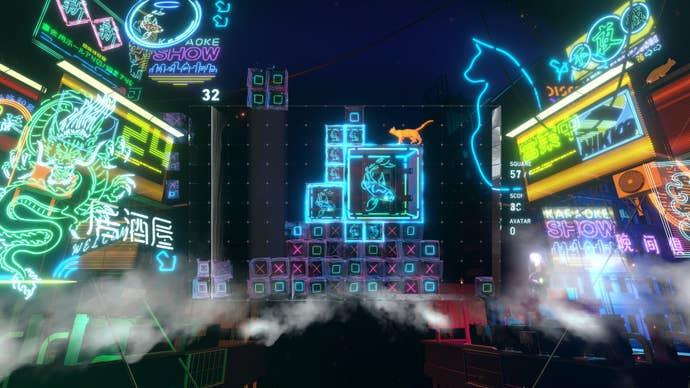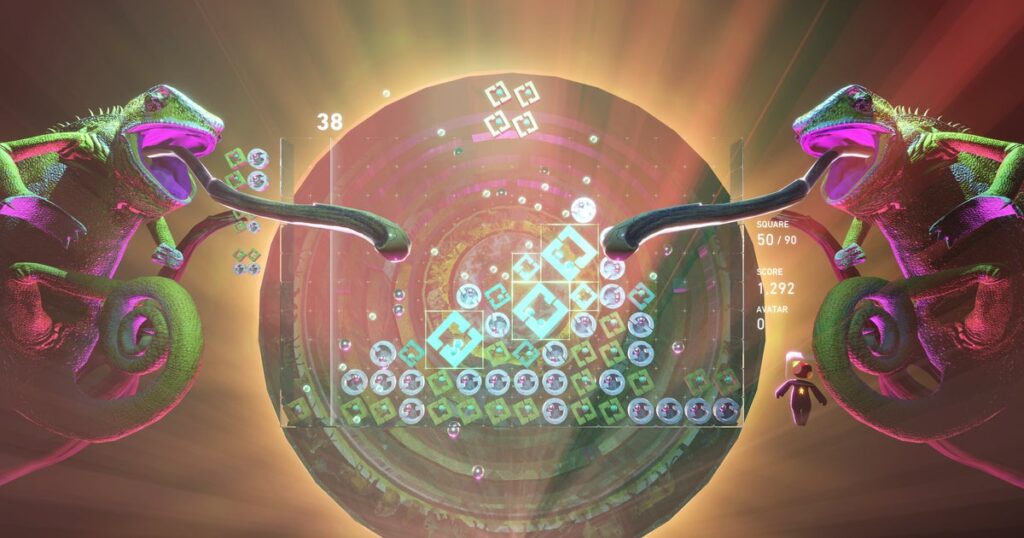For anyone who had a PlayStation Portable and a bit of taste back in the day, Lumines Arise is a gift.
This game sees Tetris Effect developer Enhance putting the Lumines puzzle formula through that same extravagant prism: the colour-matching of 2×2 blocks to the rhythm of a beat, brought to life with awe-inspiring visuals that often have a similar effect on the player’s brain as the stargate sequence from 2001: A Space Odyssey.
At this year’s Summer Game Fest, GamesIndustry.biz suggests to the game’s creative producer, Mark MacDonald, that giving Lumines the Tetris Effect treatment was exactly what a lot of fans wanted next from the studio.
“We’ve heard that a lot,” MacDonald says. “That’s been awesome to hear, every time we’ve heard that from folks here.”
The Lumines formula is simple, but like all great puzzle games, has a very high skill ceiling. Players drop two-colour 2×2 blocks onto a grid to try and form squares of the same colour. This is how they score points.
A ‘Timeline’ is sweeping across the grid of the game’s play area on a loop. Once a square is matched, the Timeline will remove the scoring blocks on its next pass, applying a short-term time pressure to either match further squares or enhance the size of their square before the points are added up.
Failure is when the player can no longer fit a 2×2 square onto the grid below, because it’s too crowded with blocks they failed to colour-match effectively. Lumines has a little bit of Tetris in its design, but the audio visual experience is a vital part of the experience, with the colours of the grid swapping out and the music switching up in intensity as the player progresses.
Lumines was last seen in an excellent 2018 remaster, which brought the joys of the original PSP title to modern platforms, most pleasingly on Nintendo Switch. Seven years later, Lumines Arise takes that audiovisual side several steps forward, with over 30 stages and evocative music by Tetris Effect outfit Hydelic.
To see this content please enable targeting cookies.
Why Lumines?
“When we did Tetris Effect, and also the Connected part, as a team we felt like we accomplished so much,” says director Takashi Ishihara. “We were able to take a very well-known, existing, globally huge franchise and were able to add our taste, our flavour, our style, and still make it work. The feedback from the fans, the users, the community, was super positive. And I feel like our team was able to make something very special [with] an existing IP.”
Winning numerous awards, including being named Eurogamer’s best game of 2018, Tetris Effect and its later Connected edition subverted expectations for anyone who felt like they’d seen everything Tetris has to offer.
“There are so many learnings that we gained knowledge of, techniques that we gained from that, that once we regrouped after seeing the success of Tetris Effect, [we went], ‘how can we take all those learnings and apply it to something we’re going to work on next?'”
Enhance – whose CEO is Rez and Lumines creator Testuya Mizuguchi – found that both its newer followers and older fans still had a lot of passion for the Lumines games, which led to this being the company’s next project.
“What if we take everything that we were able to do – not exactly copy and paste that [Tetris Effect approach] over to Lumines – but how could we make it special if we were able to bring this back?” Ishihara says. “So that’s really the original starting point of why we decided to go back, but also make it a completely new experience called Arise.”
“A lot of the [visual] inspiration comes from my own travels to locations I’ve been to, things I’ve interacted with”
Takashi Ishihara, Enhance
It’s true that Arise is not totally the same as the older Lumines games. The basic puzzle formula of matching squares by colour is at the core of it, but a new ‘Burst’ mechanic lets players charge up a bar then build a monstrously high combo by adding blocks to a growing square dropped into the grid. It’s an addition that gives the formula a little extra adrenaline rush.
Much as with Tetris Effect, the solid foundation of puzzle game design is only part of the fun, anyway. The visuals for Arise are utterly spectacular. Anyone with a PlayStation VR 2 headset is in for a treat (sadly, Meta Quest 3 owners will miss out). From dancing chameleons in the jungle to fish swimming through oceans, and people walking the streets of Tokyo, the visual variety of Arise promises to be a real event.
Ishihara – who’s responsible for the art side of the game as well as being its director – says there are always more visual ideas than the team can fit into a game.
“As an artist, and as my art team can probably back me up on this, there’s so many other worlds and environments and stages we would love to create, whether that’s in a Lumines world or not,” Ishihara explains. “But coming out of Tetris Effect and Connected, we were so hungry to go back to some of those stages or ideas that we had, that eventually either didn’t make it into Tetris Effect or we’ve always wanted to pursue further.

“So in that sense, there was a natural desire to look at this list of, ‘these are the more artsy, unique, very Lumines-esque things we want to create’. There is a unique style – the word we used is a ‘motif’ to Lumines – and it’s very much striking the balance between something that’s very edgy but maybe resonates or is relatable to people.”
Ishihara’s personal experiences, including his years at original Lumines studio Q Entertainment, help to shape the stunning worlds depicted in Lumines Arise. Right down to individual images taken from its offices.
“A lot of the inspiration comes from my own travels to locations I’ve been to, things I’ve interacted with, and so on,” he says. “One fun fact: there’s the chameleon stage in the demo. When the original Lumines was being developed at Q Entertainment, in the hallway they’d have all these different wild pieces of art, or pictures, or images hung up on the wall.
“And there is one very impactful framed piece of artwork that I remember seeing – and that was a chameleon. So to me, it’s bringing back something that I remember seeing at Q Entertainment days, walking down the hallways. I wanted to pay homage to what was there back in those days.”
Art and music
With Lumines’ second game in 2006, the divisive choice was made to include licensed music from artists like Missy Elliott and New Order. It was right as the rhythm action genre was starting to take off with the Guitar Hero franchise, and therefore made sense in the moment.
With Hydelic on-board, there was no chance of anything similar happening with Lumines Arise. In fact, the way the sound and art teams collaborate during development is a key part of why this game and Tetris Effect are able to have the impact on the player that they do, according to MacDonald.
“There’s some aspect to it that’s like, ‘we have to make something that’s visually showing this cool thing that’s happening on the sound side’, and then the art team gets inspired and they come back with something, and then the sound team sees what the art team does and is like, ‘oh shit, we need to step up our game’.”
MacDonald says that back-and-forth results in a better end product.
“Because Hydelic was very successful at creating that world-building universe view of Tetris Effect, we wanted to apply that similar formula and have Hydelic oversee the entirety of Lumines Arise as well”
Takashi Ishihara, Enhance
“That one-upping of each other, the interplay of that, you can’t get that with a licensed track, right? You end up with something that’s more than the sum of its parts and something nobody thought of from the beginning.”
Building a soundtrack from scratch also enables the team to break down each track into individual components and add reactivity to the gameplay.
“Previous Lumines, if you look at the ones that have a lot of licensed tracks in there, maybe you have a wide variety and that creates a type of experience that was meant for that Lumines,” Ishihara says.
With Journey mode, the game’s campaign, the stages are thematically tied together by music.
“For this one, we feel like there is an overall story arc and fluid experience that we want to provide,” says Ishihara, “and in order for us to achieve that, because Hydelic was very successful at creating that world-building universe view of Tetris Effect, we wanted to apply that similar formula and have Hydelic oversee the entirety of Lumines Arise as well.”
The ground floor

The one disadvantage that Lumines Arise has next to Tetris Effect, of course, is that despite their superficial similarities, the popularity and reach of Tetris is unmatched by any other puzzle game.
A PSP classic, even with its numerous excursions onto other platforms, simply doesn’t have the familiarity of a game that’s sold 520 million copies across all iterations. That means there’s a gulf in comprehension of what Lumines actually is versus the evergreen Tetris formula.
We remark upon how mastery of the puzzle mechanics feels out of reach as we complete the Lumines Arise demo during our hands-on, that we’re somehow missing a piece of information that’ll take our score multiplier to the next level. It’s something the developers have thought about a lot.
“I think you’re selling yourself short and you’re actually a pretty good player, but we do notice that there can be a gulf between a beginning player and all the different avenues of depth that the game does have,” MacDonald says.
The studio has thought of ways on how to educate players to get better at Lumines – more will be revealed around the time Enhance releases the game’s demo this summer.
“There’s basically going to be a way we can take you from a low or mid-level player to at least knowing the high techniques.”
Enhance is using this game as an excuse to create the most definitive version of Lumines yet, then, including a multiplayer offering that exceeds any previous attempts.
“We’re talking about Journey mode this time, but we’re gonna have a big multiplayer mode at launch, which is something Lumines has never been known for. I think there’s different reasons for that – PSP lineage for one thing,” MacDonald says.
“They tried a lot of different ideas, but nothing really stuck, and I think we have an idea this time for a good, true, competitive multiplayer paradigm that really leans into what Lumines is known for, which is the music, along with that Burst mechanic. We’re going to talk a lot about that.”
Those PSP diehards who feel like the Lumines experience belongs on a handheld will also be delighted to know that the game is aiming for day one Steam Deck verification. Arise is already running pretty sharply on the system, as MacDonald shows us during the demo.
In some ways, Lumines feels like a series that’s still waiting to have its moment, despite selling a few million copies over the past two decades, and despite its developers doing a great job of keeping the series available across multiple console generations. Arise’s more elaborate treatment has the potential to finally elevate the franchise to the level of popularity it actually deserves.











